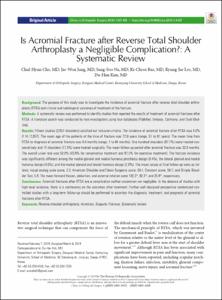KUMEL Repository
1. Journal Papers (연구논문)
1. School of Medicine (의과대학)
Dept. of Orthopedic Surgery (정형외과학)
Is Acromial Fracture After Reverse Total Shoulder Arthroplasty a Negligible Complication?: A Systematic Review
- Keimyung Author(s)
- Cho, Chul Hyun; Bae, Ki Cheor; Lee, Kyung Jae; Kim, Du Han
- Department
- Dept. of Orthopedic Surgery (정형외과학)
- Journal Title
- Clinics in orthopedic surgery
- Issued Date
- 2019
- Volume
- 11
- Issue
- 4
- Abstract
- Background:
The purpose of this study was to investigate the incidence of acromial fracture after reverse total shoulder arthroplasty (RTSA) and clinical and radiological outcomes of treatment of the fracture.
Methods:
A systematic review was performed to identify studies that reported the results of treatment of acromial fractures after RTSA. A literature search was conducted by two investigators using four databases (PubMed, Embase, Cochrane, and Ovid Medline).
Results:
Fifteen studies (2,857 shoulders) satisfied our inclusion criteria. The incidence of acromial fracture after RTSA was 4.0% (114 / 2,857). The mean age of the patients at the time of fracture was 72.9 years (range, 51 to 91 years). The mean time from RTSA to diagnosis of acromial fracture was 9.4 months (range, 1 to 94 months). One hundred shoulders (87.7%) were treated conservatively and 14 shoulders (12.3%) were treated surgically. The mean follow-up period after acromial fracture was 33.8 months. The overall union rate was 50.0% (43.8% for conservative treatment and 87.5% for operative treatment). The fracture incidence was significantly different among the medial glenoid and medial humerus prosthesis design (8.4%), the lateral glenoid and medial humerus design (4.0%), and the medial glenoid and lateral humerus design (2.8%). The mean values at final follow-up were as follows: visual analog scale score, 2.2; American Shoulder and Elbow Surgeons score, 59.1; Constant score, 59.7; and Simple Shoulder Test, 5.8. The mean forward flexion, abduction, and external rotation were 102.3°, 92.3°, and 25.8°, respectively.
Conclusions:
Acromial fractures after RTSA are a complication neither uncommon nor negligible. In the absence of studies with high-level evidence, there is a controversy on the outcomes after treatment. Further well-designed prospective randomized controlled studies with a long-term follow-up should be performed to ascertain the diagnosis, treatment, and prognosis of acromial fractures after RTSA.
- Publisher
- School of Medicine (의과대학)
- Citation
- Chul-Hyun Cho et al. (2019). Is Acromial Fracture After Reverse Total Shoulder Arthroplasty a Negligible Complication?: A Systematic Review. Clinics in orthopedic surgery, 11(4), 427–435. doi: 10.4055/cios.2019.11.4.427
- Type
- Article
- ISSN
- 2005-4408
- Source
- https://www.ecios.org/DOIx.php?id=10.4055/cios.2019.11.4.427
- Appears in Collections:
- 1. School of Medicine (의과대학) > Dept. of Orthopedic Surgery (정형외과학)
- 파일 목록
-
-
Download
 oak-2019-0314.pdf
기타 데이터 / 184.04 kB / Adobe PDF
oak-2019-0314.pdf
기타 데이터 / 184.04 kB / Adobe PDF
-
Items in Repository are protected by copyright, with all rights reserved, unless otherwise indicated.